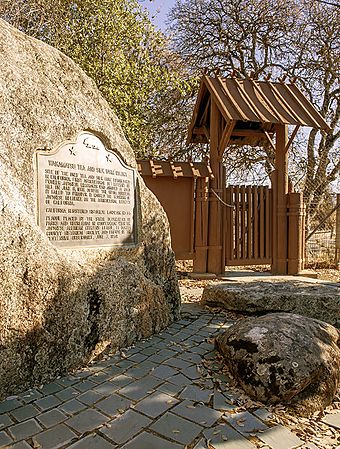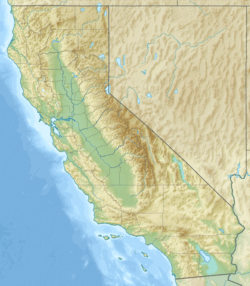Wakamatsu Tea and Silk Farm Colony facts for kids
|
Wakamatsu Tea and Silk Farm Colony Farm
|
|

Site of Wakamatsu Tea and Silk Farm Colony December 2013
|
|
| Nearest city | Placerville, California |
|---|---|
| Built | 1869–1871 |
| NRHP reference No. | 09000397 |
Quick facts for kids Significant dates |
|
| Added to NRHP | October 9, 2009 |
The Wakamatsu Tea and Silk Farm Colony was a special place. It's thought to be the first lasting Japanese settlement in North America. It was also the only time a group of samurai settled outside of Japan!
This group of 22 people came from samurai families. They left Japan during a big fight called the Boshin Civil War (1868–69). They bought land in California in 1869. Even though they showed off their farm products at fairs, the colony only lasted from 1869 to 1871.
A young woman named Okei Ito is buried here. She was the first Japanese woman known to be buried in America. A family called Veerkamp bought the farm later. They kept the farm's history and Okei's grave safe for 137 years. In 1969, Ronald Reagan, who was California's governor then, said the colony was a California Historical Landmark. Today, the American River Conservancy owns the land. They offer tours so people can learn about this important place.
Contents
Why Did the Wakamatsu Colony Start?
For a long time, Japan was a very closed-off country. It didn't trade much with other nations. But in the 1850s, the United States forced Japan to open its ports. This caused big changes in Japan. People started to disagree about how the country should be run. Some wanted to keep Japan isolated, while others wanted new ideas.
The Boshin Civil War and Samurai Migration
These disagreements led to the Boshin Civil War. This war was between those who supported the old government (the Shogunate) and those who wanted a new government led by the Emperor.
A powerful leader named Matsudaira Katamori was on the side of the old government. His samurai fighters were defeated in a big battle. Because of this loss, his life was in danger.
An American named John Henry Schnell had been helping Matsudaira. He had trained the samurai to use new weapons. After the defeat, Schnell asked Matsudaira for money. He used it to help his family and other samurai families leave Japan. They sailed to the United States. They brought special plants with them, like 50,000 mulberry trees for silkworms and millions of tea seeds.
Establishing the Wakamatsu Farm
The Japanese immigrants arrived in San Francisco on May 20, 1869. They carried many things. These included mulberry trees, silkworm cocoons, tea plants, and bamboo shoots. They also brought cooking tools and samurai swords. Newspapers were very interested in them. They praised the Japanese people's hard work.
The group wanted to start a farm. In June 1869, they bought about 200 acres of land. This land included a farmhouse and other farm buildings. They bought it from Charles Graner in the Gold Hill area.
Challenges Faced by the Colony
The colonists showed their silk cocoons and tea plants at state fairs. They did this in Sacramento in 1869 and San Francisco in 1870. However, the farm faced many problems. A big drought hit in 1871. They also didn't have enough money. Plus, there were disagreements about work.
The biggest problem was when Matsudaira Katamori stopped sending money. He had been pardoned by the new Japanese government. Schnell and his family told the other colonists they would go back to Japan for more money. But they never returned. The colonists then felt left alone in a new country. This led to the farm going bankrupt.
What Happened to the Colonists?
After the farm failed, many colonists left. A family named Francis Veerkamp bought the land in 1873. Some colonists went back to Japan. Others moved to different places to find work.
We know what happened to a few of them:
- Matsunosuke Sakurai stayed and worked for the new landowners until he died in 1901.
- Masumizu Kuninosuke married an African/American Indian woman in 1877. He moved to Sacramento and lived there until 1915. His family still lives in the Sacramento area today.
- Okei Ito came to the colony as a nursemaid. She was 17 years old. She also stayed in Gold Hill and worked for the Veerkamp family. Sadly, Okei got sick and died two years later at age 19. She is believed to be the first Japanese woman buried in America.
Okei Ito's Grave Site
Okei's grave is on a hill. It looks over the Gold Trail School. Her tombstone says, "In Memory of Okei, Died 1871. Aged 19 years. A Japanese Girl." This is written in English on the front. On the back, it's written in Japanese. The tombstone you see there today is a copy. The original one was taken down to keep it safe. There's also a copy of her gravestone in Japan.
Protecting the Wakamatsu Site
The Veerkamp family changed the farm. For 125 years, they raised cattle and ran a dairy farm. But they also worked to save parts of the Japanese Colony's history.
In the 1920s, people became more interested in the old Japanese farm. This led to many Japanese Americans visiting Okei's grave. They saw the colony as the start of Japanese immigration to America.
Recognizing the Colony's Importance
In 1969, California Governor Ronald Reagan declared the Wakamatsu Tea and Silk Farm a California Historical Landmark. This year was special for Japanese Americans. They called it the Japanese American Centennial. Important people from Japan came to the event. A special plaque was placed at the site.
The Veerkamp family also donated important items. These included a silk banner with a special Japanese family symbol. They also gave a ceremonial dagger. In 2007, they found old photos of the colonists.
Later that year, the family asked the American River Conservancy (ARC) for help. They wanted to restore the old farmhouse. They also wanted to open the site to the public. The ARC bought the site in 2010.
Thanks to the ARC and others, the Wakamatsu site is now open for tours. People can visit the historical spots. They can also attend festivals and other events. Two small farms now lease parts of the land. They practice farming in a way that respects the land's history.


